Commercial Salmon Fisheries
Southeast Alaska & Yakutat Research: Hugh Smith Lake
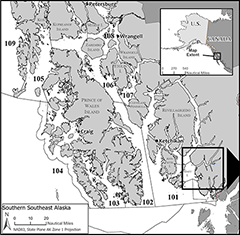
Figure 1. — Click for more Info
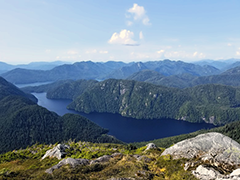
Figure 2. — Click for more Info
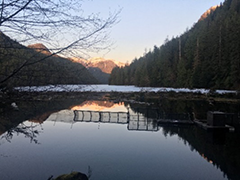
Figure 3. — Click for more Info
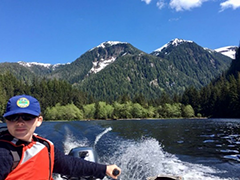
Figure 4. — Click for more Info
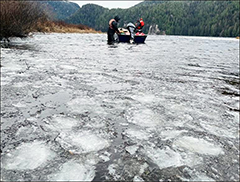
Figure 5. — Click for more Info
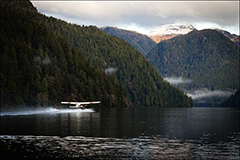
Figure 6. — Click for more Info
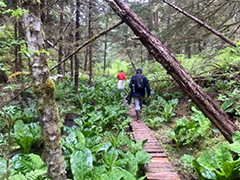
Figure 7. — Click for more Info
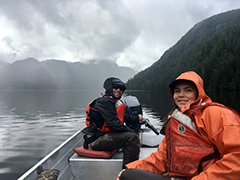
Figure 8. — Click for more Info
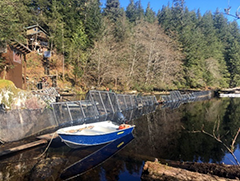
Figure 9. — Click for more Info
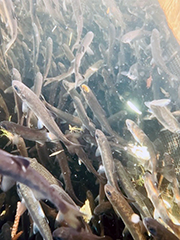
Figure 10. — Click for more Info

Figure 11. — Click for more Info
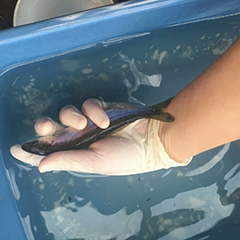
Figure 12. — Click for more Info
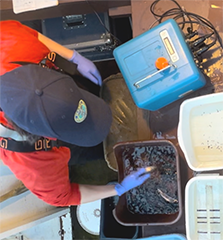
Figure 13. — Click for more Info
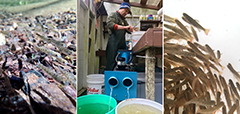
Figure 14. — Click for more Info

Figure 15. — Click for more Info
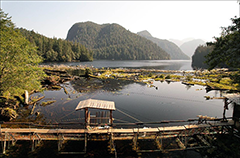
Figure 16. — Click for more Info
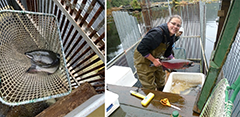
Figure 17. — Click for more Info
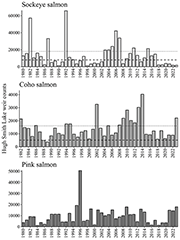
Figure 18. — Click for more Info
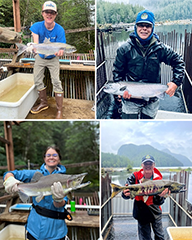
Figure 19. — Click for more Info
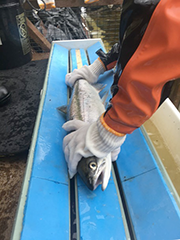
Figure 20. — Click for more Info
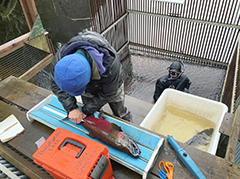
Figure 21. — Click for more Info
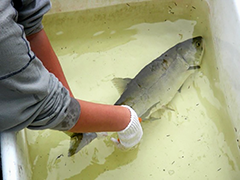
Figure 22. — Click for more Info
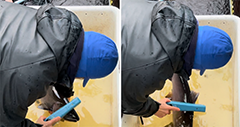
Figure 23. — Click for more Info
Introduction
Hugh Smith Lake, in Boca de Quadra Inlet, has been an important contributor to southern Southeast Alaska commercial fisheries for over a century. The Alaska Department of Fish and Game (ADF&G) has monitored adult salmon escapements through a weir at the outlet of Hugh Smith Lake from 1967 to 1971 and annually since 1980. In addition, smolt outmigration has been observed at a spring smolt weir operated annually since 1982. These population studies provide the longest time series of escapement and age, sex, and length information for sockeye and coho salmon in southern Southeast Alaska. Data collected on coho salmon allow this population to serve as an indicator stock used to evaluate existing biological escapement goals, monitor status, and estimate harvest and marine survival. Additionally, coho salmon fry have been implanted with half-length coded wire tags (CWTs) annually since 1997, which improves aging accuracy by establishing a known-age standard within each cohort. This project, along with the related Berners River coho salmon project, are the only known-age coho salmon projects in Alaska. In 2003, an optimal escapement goal of 8,000–18,000 sockeye salmon was set based on the escapement goal analysis outlined in Geiger et al. (2003). Shortly thereafter, in 2009 the current coho salmon biological escapement goal of 500–1,600 coho salmon was established, updating the previous escapement goal range.
Study Area
Hugh Smith Lake is located on mainland Southeast Alaska, 67 kilometers southeast of Ketchikan, in Misty Fjords National Monument (Figure 1). The lake, a former saltwater fjord perched approximately 2 meters above high tide, is approximately 5.5 kilometers long and 0.5 kilometers wide (Figure 2) and empties into Boca de Quadra Inlet by way of the 50-meter-long Sockeye Creek. Beach spawning by sockeye salmon has not been documented in Hugh Smith Lake: the steep-sided rocky shore along the lake perimeter limits potential spawning areas primarily to the two inlet streams. The streams are located at the head of the lake: Buschmann Creek on the east end, and Cobb Creek on the southeast side near a US Forest Service cabin. Buschman Creek is a dynamic system draining two valleys with the lower braided section especially prone to beaver activity and alteration by flood events. Cobb Creek has warmer water, and the accessible spawning habitat is limited by a barrier to anadromous migration approximately 0.8 kilometers upstream from the lake.
Living and working within the Misty Fjords National Monument
The Hugh Smith Lake field camp is up and running for most of the year. We get camp started up in spring, sometimes before the ice melts off the lake, and crew are often on site late enough in the season to see the first snow of fall (Figures 3–5). The staff and weekly supplies are predominantly brought in by float plane, but the lake is also accessible by boat and a short tide-dependent walk up the saltwater trail (Figures 6–8). Generally, a two-person team is on site to perform the various fieldwork required, and additional crew are used to install and demobilize camp and weir structures, or occasionally assist with other needs. The season is broken into three sequential projects: 1) smolt, 2) adult sockeye salmon, and 3) adult coho salmon seasons, and project goals overlap immensely, so through much cooperation and coordination the Hugh Smith Lake teams works together to efficiently accomplish project goals every year. These field efforts are the foundation for successfully monitoring sockeye and coho salmon stocks at Hugh Smith Lake, a one-of-a-kind, long term data series which in turn is used to monitor the health of salmon in Southeast Alaska.
Smolt Sampling:
The season begins with the installation of a smolt weir with the primary goals of estimating outmigrating abundance of sockeye and coho salmon smolt, and implanting coho salmon with CWTs that allow biologists to determine the productivity and harvest of Hugh Smith Lake coho salmon. Each CWT is approximately 1 millimeters long and contains microscopic numbers to link the tag to the location and year it was implanted. The smolt weir has been operated annually since 1982 from late April to early June with few exceptions. The weir is made of eight mesh covered panels with mesh wings designed to span the channel which funnels smolt into an inclined-plane trap (Figures 9 and 10). The trap is checked for catch every 3 to 12 hours and captured fish are sorted by species and enumerated (Figure 11). In addition to sockeye and coho salmon, other species are observed at the weir including rainbow trout, cutthroat trout, Dolly Varden, pink salmon fry, and adult steelhead.
Some sockeye and coho salmon smolt collected at the trap undergo further sampling (Figure 12). Scale samples (for age composition), length, and weight data are collected daily from a subsample of the population of both sockeye and coho salmon. While the age compositions vary from year to year, most sockeye salmon outmigrating from Hugh Smith Lake have been residing there for 1 year or 2 years, and a small portion leave after 3 years. Similarly, most coho salmon at the lake tend to leave after rearing in stream or back-channel habitat after just 1 year, but some remain longer and leave after 2 years.
After sampling, coho salmon smolt that can safely be tagged are implanted with CWTs (Figure 13). This means a tiny tag is carefully and precisely inserted in the smolt's snout using a tagging machine. Then the adipose fin is clipped for easy recognition that the fish is tagged. The CWTs are later recovered in adult coho salmon returning to Hugh Smith Lake or in Southeast Alaska fisheries and provide vital information necessary to monitor Hugh Smith Lake coho salmon. By collecting information across the whole life history of coho salmon — during smolt outmigration, from the fisheries, and returning adults — this stock is a full indicator stock that documents trends occurring in southern Southeast Alaska. Over the course of the project between 5,500 and 29,400 coho salmon smolt have been tagged annually.
Fry Tagging:
To assist with accurate age estimation, each spring approximately 3,000 coho salmon fry are captured immediately after they hatch from eggs and implanted with half-length CWTs (Figure 14). This means recoveries of half-length tagged smolt and adults can be assigned to a known brood year. Since the fish's age is known with certainty, we refer to them as known-age fish. As they out-migrate in subsequent years the known-age fish will be recaptured as a mix of age-1 and age-2 fish at the smolt weir near the outlet of Hugh Smith Lake. Each year, 40 of the known-age smolt will be euthanized to calibrate smolt scale readings. The remaining known-age smolt will be injected with a dorsal CWT ("back tagged") for potential recovery as known-age fish in ensuing adult returns.
Adult enumeration, escapement, and harvests
An adult weir has been operated annually at Hugh Smith Lake since 1980 to enumerate returning adult salmon and determine if the escapement goals were met. The Hugh Smith Lake weir is an aluminum bipod, channel-and-picket weir with an upstream trap for counting and sampling salmon (Figures 15). It is located at the outlet of the lake, approximately 50 meters from the saltwater. Generally, the weir is installed shortly after the smolt weir is removed and operates from mid-June through early November with few exceptions. A gate on the upstream side of the weir trap allows the crew to visually identify fish to species and count them as they swim unimpeded into the lake, or conversely drop the gate to trap and sample fish in the trap box as needed (Figures 16 and 17).
Historically, sockeye salmon return in the largest numbers (average 13,300; range 1,100–65,700), followed by pink (average 9,800; range 1,100–17,300) and coho (average 1,400; range 430–3,300) salmon, and chum salmon occur in small numbers (Figures 18 and 19). Hugh Smith Lake sockeye salmon have exceeded the lower bound of the escapement goal 52% of the time since 1980, with two major periods of weakness from 1998–2002 and 2018–present; the stock was listed as a stock of concern from 2003-2006. Hugh Smith Lake coho salmon have exceeded the lower bound of the escapement in all but 2 years from 1980 to present.
Additional sockeye and coho salmon sampling occur at both the spawning streams and the weir. Age, sex, and length data are collected from a subset of returning sockeye and coho salmon (Figures 20 and 21), based on each species' run timing, to determine the age composition of the escapement and monitor trends in fish size at age. A portion of sockeye salmon and all coho salmon are marked externally with a fin clip (Figure 22). All coho salmon are also examined for the presence of an adipose fin and CWT (Figure 23).
If an adipose-clipped coho salmon has a dorsal tag, a suspected half-length snout tag, or no snout tag, it is likely a known-age sample and therefore very valuable to help determine ages. All suspected known-age adult coho are sacrificed, sexed, measured for length, and 10 very valuable scales are collected. The head containing the CWT is labeled and submitted to the ADF&G Mark, Tag and Age Laboratory so that they can extract and read the tag code to determine the date and location the tag was implanted.
In addition to the weir count, a mark-recapture study is conducted for sockeye and coho salmon. First an initial time-varying and species-specific mark is made at the weir, then recapture efforts made in Buschmann and Cobb Creeks are used to generate mark-recapture estimates of the total spawning population of sockeye and coho salmon longer than 400 millimeters. The mark-recapture estimate helps verify the weir count and can be reported as the official escapement estimate if the weir count is compromised, which has only occurred a handful of times over the course of the years. Also, from mid-August through November, weekly foot surveys are conducted on both inlet streams (Buschmann Creek and Cobb Creek) to count all live and dead salmon by species.
Commercial Harvest, Total Run & Harvest Rate
Hugh Smith Lake coho salmon harvest estimates are calculated using CWT recoveries in the commercial catch. ADF&G Port Sampling and Creel personnel stationed at processors and fish buying stations across the region can sample representative marine fisheries in Southeast Alaska for coded wire tagged coho salmon. Harvest across the border in Canadian sport and commercial fisheries is conducted and reported annually by Department of Fisheries and Oceans (DFO) staff. Fish of interest are identified by the adipose fin clip (i.e., missing adipose fin), and snouts from these fish are sent to the CWT lab for extraction and reading. After CWTs are read, those implanted at Hugh Smith Lake each year can be identified by the unique tag code. We then assign a proportion of the commercial catch as tagged Hugh Smith Lake coho salmon stock, and once the proportion of tagged Hugh Smith Lake coho salmon in the return is known, we calculate the total Hugh Smith Lake stock contribution to the commercial catch. Recoveries are calculated for each gear group, area, and statistical week. The total run can be calculated as the total Hugh Smith Lake stock contribution to commercial and sport fisheries plus the escapement count at the weir. Finally, we can calculate a harvest rate by dividing the total Hugh Smith Lake contribution to the commercial catch by the total run. This detailed quantitative information, and the extended time series of data, are what makes Hugh Smith Lake a full indicator stock.
Hugh Smith Lake sockeye salmon harvest estimates are calculated using genetic stock identification (GSI) analysis. Sockeye salmon tissue samples are collected at the major fish processing ports in Southeast Alaska by the ADF&G Port Sampling Program. The recoveries are segregated into district, gear, and statistical weeks, and the proportions of each sample assigned to Hugh Smith Lake sockeye can be applied to the total catch in the same strata (district, gear group, and statistical week), and the sum of all gear groups and weeks is the total estimated commercial catch of Hugh Smith Lake sockeye salmon. The total commercial catch paired with the escapement counted at the weir allows the calculation of total run, and harvest rate in the same way as for coho salmon. For both sockeye and coho salmon, harvest rates vary from year to year, and also by district, gear type and week of harvest.
Selected Publications
- Hugh Smith Lake Sockeye Salmon Stock Assessment, 2021 FDS (Fish and Piston) (PDF)
- Coho Salmon Stock Status in Southeast Alaska: A review of Trends in Productivity, Harvest, and Abundance through 2019 (Priest et al 2021).
- Stock status and review of factors affecting coho salmon returns and escapements in Southeast Alaska (Shaul et al 2019) (PDF)
- Coho Salmon Stock Status and Escapement Goals in Southeast Alaska (Shaul et al 2011) (PDF)
- Coho Salmon Studies at Hugh Smith Lake, 1982–2007 (Shaul et al 2009) (PDF)
- Hugh Smith Lale Sockeye Salmon Adult and Juvenile Studies, 2008 (Piston 2009) (PDF)
- Distribution and Run Timing of Hugh Smith Lake Sockeye Salmon in the District 101 Commercial Net Fisheries of Southern Southeast Alaska, 2004–2006. (Heinl et al 2007) (PDF)
- Sockeye Salmon Stock Status and Escapement Goal for Hugh Smith Lake in Southeast Alaska (Geiger et al 2003) (PDF)
- Limnological and Fisheries Investigations at Hugh Smith Lake, Southeast Alaska 1998 (Zadina and Heinl 1999) (PDF)
- Operational Plan: Southeast Alaska coho stock assessment, 2022–2024 (Priest and Fish 2023) (PDF)
- Operational Plan: Hugh Smith Lake Sockeye Salmon Stock Assessment, 2019–2021 (Brunette 2019) (PDF)
- Evidence for Temperature Limitation of Juvenile Sockeye Salmon, Oncorhynchus nerka, Growth in Hugh Smith Lake, Alaska (Peltz and Koenings 1989) (PDF)
